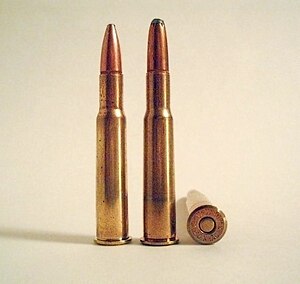First cartridge adopted by the US Army that was designed for smokeless powder.
| .30-40 Krag |
|---|
 |
| Type | Rifle |
|---|
| Place of origin | United States |
|---|
|
| In service | 1892–1903 |
|---|
| Used by | United States |
|---|
|
| Designed | early 1890s |
|---|
| Produced | 1892–present |
|---|
|
| Case type | Rimmed, bottleneck |
|---|
| Bullet diameter | .308 in (7.8 mm) |
|---|
| Land diameter | .301 in (7.6 mm) |
|---|
| Neck diameter | .338 in (8.6 mm) |
|---|
| Shoulder diameter | .423 in (10.7 mm) |
|---|
| Base diameter | .457 in (11.6 mm) |
|---|
| Rim diameter | .545 in (13.8 mm) |
|---|
| Rim thickness | .064 in (1.6 mm) |
|---|
| Case length | 2.314 in (58.8 mm) |
|---|
| Overall length | 3.089 in (78.5 mm) |
|---|
| Case capacity | 58.0 gr H2O (3.76 cm3) |
|---|
| Maximum pressure (C.I.P.) | 47,137 psi (325.00 MPa) |
|---|
| Maximum CUP | 40,000[1] CUP |
|---|
|
|
|
|
| Bullet mass/type |
Velocity |
Energy |
| 100 gr (6 g) SP |
2,898 ft/s (883 m/s) |
1,865 ft⋅lbf (2,529 J) |
| 130 gr (8 g) HP |
2,746 ft/s (837 m/s) |
2,177 ft⋅lbf (2,952 J) |
| 150 gr (10 g) Nos Part |
2,575 ft/s (785 m/s) |
2,209 ft⋅lbf (2,995 J) |
| 180 gr (12 g) SP |
2,276 ft/s (694 m/s) |
2,071 ft⋅lbf (2,808 J) |
| 200 gr (13 g) RN |
1,974 ft/s (602 m/s) |
1,731 ft⋅lbf (2,347 J) |
|
| Source(s): Hodgdon [2] |
The .30-40 Krag, also known as the .30 U.S. and .30 Army, was a rifle cartridge developed in the early 1890s to provide the U.S. armed forces with a smokeless powder cartridge suited for use with modern small-bore repeating rifles to be selected in the 1892 small arm trials. Since the cartridge it was replacing was the .45-70 Government, the new cartridge was considered small-bore at the time. The rifle ultimately selected for use by the Army was the Krag–Jørgensen, formally adopted as the M1892 Springfield. The cartridge was also used in the M1893, M1895, M1897, and M1900 Gatling guns.[3][4][5][6]
